Covering Cakes with Fondant- A Cake Decorating Video Tutorial
In this cake video tutorial, I'll show you the basics of covering a cake with fondant.
Fondant is an edible sugar dough that is used all over the world to create beautiful cakes with a smooth finish.
Table of Contents
What Type of Fondant is Best?
There are many different opinions on the best brands or recipes of fondant.
Satin Ice and Wilton are good options and are not too expensive.
I use Liz Marek's recipe most often which is a combination of pre-made fondant and marshmallow fondant. You can find the link HERE. (I love it because it is more elastic, tastes like marshmallows, and I never have issues with elephant skin or tearing.
In this video, I cover my settled, buttercream crumb-coated cake with fondant rolled approx. ⅛" thick. I applied my buttercream slightly thicker than a usual crumb coat. Apply your frosting just thick enough to make the cake surface nice and smooth.
Using Ganache Beneath Fondant
You do not have to use buttercream beneath the fondant. In fact, many decorators prefer to use ganache frosting which is firmer and less likely to bulge.
Hop over if you'd like to see my Spreadable Ganache recipe in the Recipes section. It creates a really nice, sturdy foundation for fondant.
Steps for Covering Cakes with Fondant
Chilling the Cake
First, I like to place the frosted cake in the freezer for about 15-20 minutes just before covering with fondant. Chill until the frosting is nice and firm. If you skip this step, the frosting with shift as you apply the fondant.
Condensation
If you leave the cake in the freezer for too long (an hour or more), you will likely have condensation after applying the fondant.
You just want the outer layer of the cake to be chilled and firm when applying the fondant. However, if this happens to you, don't touch the fondant. Place the cake in front of a fan and the moisture will evaporate over time.
Rolling out the Fondant
While the cake is chilling, you can roll out your fondant. First, lightly grease the counter with a very thin layer of vegetable shortening. (Some decorators use a dusting of cornstarch or powdered sugar instead but I prefer shortening unless my fondant is very, very soft).
Roll the fondant to about ⅛ inch thickness (or less).
Covering the Cake
Remove the cake from the freezer.
Preparing the tier for fondant: I find that fondant adheres well to the chilled buttercream or ganache. If your crusted buttercream or your ganached cake seems too dry for fondant to adhere, mist it with a tiny bit of water or rub with a very thin layer of shortening.
Roll the fondant up onto a long rolling pin. (If it sticks to itself, you can dust it with a bit of powdered sugar.)
Unroll the fondant over the cake and then smooth the top and around the top edge of the cake first. This will keep the fondant from pulling down and tearing.
Then, work you way down around the sides. When the fondant wrinkles, just fluff/gently pull the fondant slightly away from the cake and go back in again, smoothing it around the sides.
Finally, trim away the excess with a pizza cutter or xacto knife.
More Fondant Cake Tutorials
We have other fondant tutorials that you may find helpful.
- Here is our tutorial on how to create and cover a cake with Marbled Fondant
Here is a tutorial on How to create and cover a ball/spherical shaped cake with fondant
In our Sledding Snowman Cake, you will see how I cover a spiral carved cake tier with fondant.
Here, we covered our Topsy Turvy Cake in fondant
And finally, How to Cover a Square Cake with Fondant
Enjoy the video!
We hope that you enjoy this quick video on covering cakes with fondant. You will notice that this is one of our older videos ;0)
We do plan to redo some of these oldies but until then-- the information and process has not changed over the years. I hope that you find it helpful!

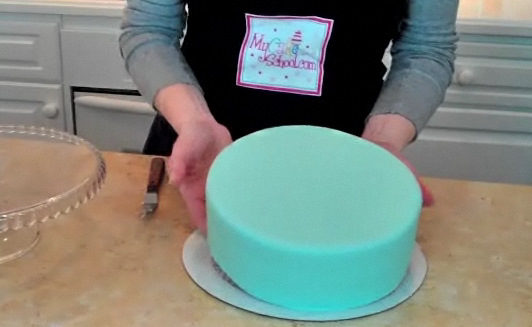
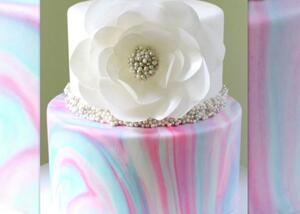
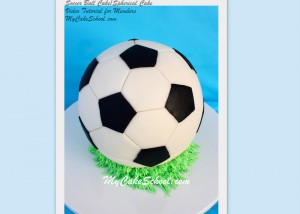

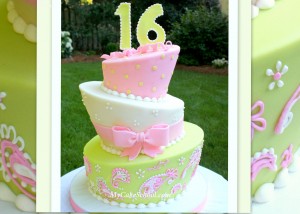
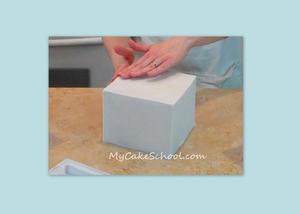
Hi Melissa and BeBe, If using buttercream under fondant, which recipe works best? All butter or one using butter and shortening? I love your fluffy buttercream recipe, but wasn't sure what should go under fondant. Thank you in advance!
Hi Fran, you can use either under your fondant. You might want to chill your cake a short while, 10 minutes or so to firm up the buttercream before laying on the fondant........that will make it easier to reposition your fondant if you need to.
Thank you, BeBe!
Hi Bebe & Melissa, I need advice on covering a square cake with fondant, the corners always come out messy. Also, I can't fit the cake in the freezer for a few minutes for the buttercream to crust how long should I put it in the refrigerator about an hour not sure because I don't want the cake to get cold thru & thru any suggestions.
P.S. I'm making your White Almond Sour Cream Cake, which is excellent by the way! I'm also using your sheet cake method except in your video you call for 11 cups of batter in each pan size 11×15″ . I'm using a 12x18" pan I'm figuring about 14 cups of batter is that sufficient? Thanks much love your help don't know what I'd do without you ! ! ! :)
Hi Fran, click on this link to another question on this topic and Melissa's response: https://www.mycakeschool.com/message-boards/video-requests-and-announcements/covering-a-square-cake-in-fondant
Your buttercream should firm up nicely in the refrigerator in 15 - 20 minutes, just until it feels somewhat firm to your touch.
You might also like to visit this link on fondant amounts for square cakes:
Yes, 14 cups of batter should be right for your 12 x 18 pan.
Hey Melissa,
This by far has to be the best website ever. Quick question, do u just crumb coat the cake before wrapping it in fondant or crumb coat and another coat? Also how do u get the edges so sleek versus bulky. Would the fondant thickness matter?
Hi Melissa,
When I have a perishable filling, how long can i leave the fondant covered cake outside?
I am always scared if I leave it for a day or more it will go bad.
Thank you for you help!
@Candace~ I've done it both ways successfully. In fact...I have to stop and think what I normally do ;0) - Most of the time, I crumb coat...allow to settle, bring to room temp (if it settled in the fridge), and then add another thin coat if any minor bumps or bulges appeared during the settling process. ** Not to confuse, but you could also wrap your "naked" filled and stacked layers in plastic wrap, settle for several hours with a weight of some sort on top (thin book, thick magazine, etc.), and then crumb coat a little thicker than usual.
The main idea is that you want to lay your fondant on a nice, smooth surface. I chill my frosted/ganached cake briefly for just a few minutes in the freezer. Just long enough to firm up the icing. You don't want the cake to be cold through and through....but you want a firm outer layer so that the icing isn't pushed around beneath the fondant during the smoothing process.
The thinner the fondant, more crisp you can get your edges. However, there's a bit of a learning curve. You are more likely to experience tearing if your fondant is extremely thin...and any imperfections in the frosting or ganache will be more likely to show. I usually roll my fondant closer to 1/8 inch.
Hi Julia--Thanks for your question. It varies. What type of filling? You definitely don't want to leave anything perishable at room temp for a day or two. The same rules of apply, even if the perishable ingredient sandwiched between cake layers :0) --
Hi Melissa & BeBe - I am planning to cover a cake with fondant ruffles. Do you think I need to cover the cake fully in fondant & then attach the ruffles to the fondant, or do you think I could simply attach the ruffle strips to the cake itself?
Hi Melissa
How do you cover a 5 inches cake with fondant without winkles, tearing? I have no problem with 3 inches but more than that its a nightmare for me. Most of the time I will have to cover up with unplanned decos. HELP!!